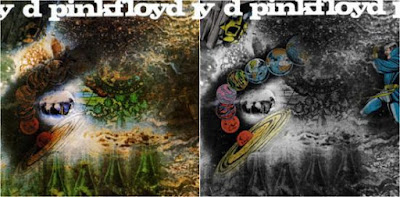 |
| I probably should have expected a strange movie, with a title like that. |
There are two major criticisms of the perpetually-unfolding,
undeniably-
successful 14-film (so far) franchise known as the Marvel Cinematic Universe (MCU). The first is that the films in this series, from 2008's
Iron Man to this November's
Doctor Strange, are overly formulaic. They present a competent, if unspectacular, mix of action, comedy, and relatively high (but always diffused) stakes with a standard hero's journey narrative, and maximize the whole recipe for popular consumption. The second criticism, related to the first, is that MCU movies tend to lack a strong villain (Tom Hiddleston's Loki excepted). Every MCU villain is usually either a dark mirror of the hero, some deep-voiced cosmic threat bent on mass destruction, or both.
You could say both of these things about
Doctor Strange. Its basic narrative is the hero's journey of Stephen Strange (Benedict Cumberbatch, doing his best Gregory House impression), a brilliant, arrogant, sarcastic, know-it-all neurosurgeon who loses the proper use of his hands after a car accident and goes wandering to the Himalayas for answers after exhausting every other recourse, becoming a mystical defender of Earth in the process. Along the way, of course, he confronts difficulty, is humbled, and emerges from the process a better man. And he has, in Christine Palmer (Rachel McAdams), a(n) (ex-)love-interest; in the Ancient One (Tilda Swinton) and Karl Mordo (Chiwetel Ejiofor), two wise mentor figures; and, in Kaecilius (Mads Mikkelsen), a megalomaniacal, dark-mirror villain (in thrall to a deep-voiced cosmic threat). So, yes, you could say it's all there.
 |
| "Call me 'formulaic' one more time..." |
But that paragraph above should provide your first hints that
Doctor Strange does something special within the somewhat predictable Marvel template. Just
look at that cast. Cumberbatch, one of the best younger representatives of the classically-trained British school of acting working today, at first might as well be playing Robert Downey, Jr., playing Stephen Strange. By the end of the film, though, he has given his character a satisfying, credible arc, distinguishing him from Downey's Tony Stark/Iron Man. McAdams is a bit underused, but at least does a bit more than the typical movie damsel, saving Strange on at least one occasion. Swinton, who must now serve as
a proxy David Bowie after
the Thin White Duke's death, imbues her role with an alluring mysticism. Ejiofor puts way more soulfulness into Mordo than you'd expect for a Marvel movie, selling you on his character's interesting philosophical journey. And Mikkelsen pulls off that classic movie villain trick of acting like he's the hero of the story, making you wonder whether he has a point or two. All of these performances (and, frankly, the actors who provide them), and some I didn't mention, are almost gratuitously exquisite for a Marvel movie.
And it's not just the actors that make
Doctor Strange more than just the Marvel formula. A thoroughgoing psychedelic spirit, consistent with the 60s culture origins of the original comic book character, also helps. You see it in big things, such as the (surely-
Inception-inspired) manipulation of time, space, and planes of existence to make the action scenes way more interesting than they otherwise might have been, and in the various other sequences to which the word "trippy" rightly applies. Most profound is one sequence where two characters discuss their mortality while watching lightning crawl across the sky in slow-motion, a scene I'd argue qualifies as one of the most unique and affecting to appear in any Marvel movie to date.
 |
| One of the trippier scenes of the movie. |
You also see it in little things, such as scoring one key scene to "
Interstellar Overdrive," a song from Pink Floyd's 1967 psychedelic/space rock album
The Piper at the Gates of Dawn (to which I listened while writing this review, and
which I highly recommend), and having Marvel legend Stan Lee read Aldous Huxley's
The Doors of Perception, a founding text of the hallucinogenic 1960s (Jim Morrison named The Doors after the book), during his requisite Marvel movie cameo. I am a sucker for psychedelia, so I may be a biased judge in this area. You can be sure that, if
Doctor Strange came out in the late 60s, drug-addled college students would be packing theaters to drop acid to it (though the special effects of the movie would have been impossible until the past few years). But, my psychedelic bias aside, this stylistic choice allows
Doctor Strange to do things that make it far more novel than you'd expect.
 |
| Fun fact: Doctor Strange appeared on the cover of Pink Floyd's 1968 album A Saucerful of Secrets |
One of these choices--to introduce and rely heavily on time travel as a plot device--was both interesting to me as a time travel aficionado, and potentially worrisome. I don't want to say too much, since, as with
Arrival, at least some of your enjoyment of the movie will likely depend on how well you think this time travel becomes part of the narrative. I will say this, though: In future movies, people may wonder why Doctor Strange doesn't just do
this anytime something is too difficult. For now, however, Marvel movies continue to qualify as consistently above-average entertainment--working from a formula, to be sure, but one that seems to work, and one individual movies still seem capable of making interesting. And
Doctor Strange is no exception.




So Cumberbatch apparently bridges the fictional world by playing a doctor who is 'doing his best Gregory House impression,' while House himself is presented as the 21st century medical version of Sherlock Holmes, and Cumberbatch also plays the modern incarnation of the sleuth of Baker Street on BBC.
ReplyDeleteA fit of self-referential trippiness appropriate for this movie.
Delete